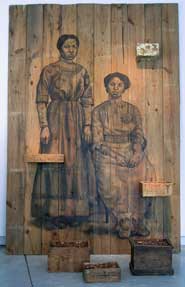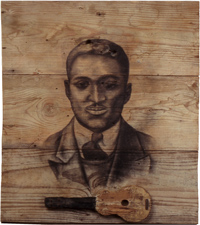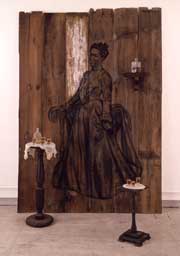Past Present
by Hilarie M. Sheets, Art News
“THE IMPORTANCE OF HOME, FAMILY, ANCESTRY feeds my work entirely,” says Whitfield Lovell, known for his large-scale images of African Americans, drawn in charcoal on weathered wood planks. “African Americans generally were not aware of who their ancestors were, since slaves were sold from plantation to plantation and families were split up.”

“Having,” 2000, 108x72x45, charcoal on wood, found object.
Many of Lovell’s drawings are based on studio portraits of formally dressed African Americans, dating largely from the early 20th century. “Any time I pick up one of these old vintage photographs,” he says, “I have the feeling that this could be one of my ancestors. These images are stand-ins for the people I don”t know about.”
Settled into a well-worn armchair in his studio space at the heart of the East Village loft where he lives with the artist Fred Wilson, Lovell, 48, clearly has an affinity for things past. As jazz music from the 1950s drifts through the room, he talks at a leisurely pace about his life and his art, much of which seems conjured from an earlier time and place. From a very young age, Lovell says, he began frequenting flea markets with his grandmother, who first gave him an appreciation for antique objects. Since then Lovell has been a tireless collector—early on, of coins, Hot Wheels cars, balls, records, and cuff links. Now, along with photographs, he amasses instruments, boxing gloves, playing cards, tea sets, radios, and many other objects purchased from flea markets and on eBay that fall into the category “Black Americana.”
Populating his densely packed yet well-ordered loft, these objects all seem invested with a story. Since the mid-’90s, they have also found their way into Lovell’s artworks and installations, which often combine drawings with three-dimensional items. “It was a real thrill to start working with objects, because I had an excuse to buy more things,” he says jokingly.
He points to three life-size images of African American soldiers in uniform from World War I, beautifully rendered on wood riddled with knotholes, displayed with groupings of antique globes. Lovell began this series of military people after hearing the story of a group of black soldiers who were court-martialed and hanged at Camp Logan in Houston in 1917. Their infraction was that they had worn their military uniforms in public, inciting a riot and violence in Houston. Although Lovell wasn’t focusing on the holes in the planks when he selected them, he says that inevitably people read them as bullet holes, adding a powerful layer to the images of the soldiers.
“I became interested in the way African American soldiers were treated in the United States once they came back—the contradiction of fighting for a country that doesn’t allow you basic human rights,” says Lovell. “What would motivate someone to join the service under those circumstances?”
For Lovell the clusters of globes refer to “the fact that a lot of African Americans could see the world by enlisting.” His grandfather, who was from rural South Carolina, had tried to join the service because he dreamed of going to Africa. “One of his favorite stories to tell was that they turned him down because he was too short,” Lovell recounts. “There was another black man who came out of the office before my grandfather went in. He said, ‘Well, they told me I”m too tall!”’
Soft-spoken in demeanor yet a comfortable raconteur, Lovell tells of how he learned last fall that he had been awarded a MacArthur Fellowship, nicknamed the “genius grant.” When a telephone caller asked for the artist by first and last name, Lovell assumed he was a telemarketer. Lovell immediately said that Whitfield Lovell wasn’t in, and asked if he could take a message. The caller implied he was interested in Lovell’s work. “I’m thinking, it’s too late now to be me,” Lovell recalls with a laugh, so he encouraged the caller to try again later. Lovell typically works through the night and sleeps until midday, and he heard the phone ring repeatedly the next morning. He finally retrieved an urgent message—from the same voice—to call the MacArthur Foundation.
“I wouldn’t allow myself to think he was actually calling to give me one,” says

“Serenade,” 2001, 27×24, charcoal on wood, found object.
Lovell, who, assuming the man wanted a recommendation for another candidate, was then stunned to receive the news.
His recognition came after decades spent juggling teaching and studio time. He says that the MacArthur grant might make him a little less hesitant to spend money on things—he’s excited about $2,000 worth of vintage mug shots he recently bought, because it’s rare to find a profile in vintage portrait photographs—but mostly it’s changed his outlook. “I’ve been sort of levitating,” he says.
Lovell was born and raised in the Bronx, and his artistic direction came early. His father, a serious amateur photographer, always had his camera at family dinners and parties, and
Lovell assisted him in the darkroom as a child. “I knew who I was and where I came from through his photos,” he says. “My grandmother had photo albums that told the chapters that came before.” Lovell lived near his grandparents and would accompany his grandfather each summer to South Carolina. He was fascinated by the different world of his extended family in the South—like his great-aunt, who died at 105, wore Victorian gowns, lived in a wood shack, and didn’t use electricity.
Lovell showed early talent in both drawing and singing. He studied voice—he admits that he loved to sing torch songs—but was too shy to perform in front of strangers. He remembers an art teacher from junior high who would spend her lunch hour critiquing the drawings he had made at home at night. “I went to a really rough all-boys school in the Bronx, and this just saved me,” he says. Lovell was then accepted to Fiorello H. LaGuardia High School of Music & Art and Performing Arts in Manhattan. “Being sensitive and talented there didn’t make you odd,” he says. From that time on, he never doubted being an artist.
His experience in college, though, was very discouraging. He spent a year each at the Maryland Institute College of Art in Baltimore and Parsons the New School for Design in New York before starting at the Cooper Union in 1979. He was one of only two black students in the school of art, and he felt ostracized. “I would go in with these portraits that my grandmother had posed for, and the whole class would have a discussion among themselves about ‘this social realism that’s coming out of his world into our world,'” he says. “It was like my work had no relevance because I wasn’t part of their world.” During this time Lovell was also traumatized by the death of his sister from a rare skin disease. He recalls, “It was all I could do to graduate and still feel that I had a desire to be making art.”
After graduating in 1981, Lovell discovered a more compatible network through New York’s alternative art spaces, and he met Wilson during that time. Friends encouraged him to apply for a residency at the Skowhegan School of Painting and Sculpture in Maine. He began one in 1985, shortly after his grandfather was killed in a mugging. He views his time there as an important turning point. “I had been doing what I would say is ‘art for art”s sake,'” says Lovell. At Skowhegan he got rid of color and canvas and started working almost exclusively with charcoal and oil stick on paper. “The change was realizing there was something unique about my life that had to be put out there in more narrative and concrete ways,” he says. Lovell also began finding expressive methods of using the figure without focusing on a likeness. He sometimes made bodies without heads, or images of hands or empty clothing, as a way of dealing with the losses in his life.
He remembers first having the impulse in 1987 to juxtapose a colorful, kitschy plaster flea-market bust with a drawing of two headless people dancing. “I held both of them up, and it just really popped,” says Lovell. But he talked himself out of continuing down this path because he thought it would be expensive to pursue.

“Bliss,” 1999, 95x67x46, charcoal on wood, found object, liquor
He revisited the idea of combining objects with drawings in 1995, when he took a sabbatical from his heavy teaching load at the School of Visual Arts in New York and accepted a residency at Rice University. He was invited to create an installation for Project Row Houses in Houston, an inner-city community organization that integrates art related to the African American experience with social activism. Lovell’s installation filled one of eight shotgun houses there “When I walked in, I just knew I was going to make images of people who looked as if they could have lived in that house,” says Lovell. “I wanted the images to feel like spirits, in a way.” It was the first time that Lovell both drew directly on bare wood walls and worked with photographs of strangers, which he found in antique shops in Houston. “I liked that the people had some connection to the location,” he says.
Lovell describes flipping through photos until he sensed something familiar and accessible in the person depicted and had the feeling that he or she somehow wanted to be on the walls. (This way of working with photos continues today.) In a side room of the house Lovell placed a bed with a quilt and personal effects like clothing and cigarette butts, and incorporated a sound track with gospel music and the voices of people at a family dinner. A collector who saw Lovell’s installation wanted to buy one of the figures, so the artist arranged to have a carpenter cut a chunk out of the wall. Contemplating the resulting object, Lovell “saw the drawings in a different context and became very excited about the potential,” he recalls. He has predominantly used this format slabs of wood that look like small sections of a wall ever since. “Whenever I see these planks, I think about the house they might have come from,” he says.
Diana Block, who recently retired as director of the University of North Texas Art Gallery, first saw Lovell’s work at Project Row Houses. “Being in the little wood house and confronting these people on the walls was an amazing experience, particularly for a white girl from the South,” says Block who grew up in Dallas. “I was in school through the ’50s pre-integration. I was enchanted and strongly moved by seeing all these beautiful, ordinary figures from the past, who would have been from my own past had my life been different.”
Block invited Lovell to do a residency at the university located in Denton. Out of that grew his installation “Whispers from the Walls,” which opened at the university gallery in 1999, traveling over the next six years to 15 other venues including the Seattle Art Museum and the Studio Museum in Harlem. The centerpiece was a wood cabin, whose doorways, window, and mirrors framed the people on the walls in domestic vignettes—a kitchen corner, a dressing area. The room was filled with the smells of the objects and the whispers of a sound track, an experience Block compares to that of being in a chapel. Viewers had to navigate a field of old clothing to enter the house. Ringing the gallery walls were several figures rendered on sections of wood, objects that Lovell now calls his tableaux.
After the acclaim he received for “Whispers from the Walls,” and a lucrative commission in 2001 from a prominent African American celebrity, Lovell was able to leave his teaching post at the School of
“Whispers from the Walls,” a traveling exhibition that opened in 1999, featuring a wood cabin, portraits on wood, objects, and a whisperu sound track, evoked an earlier era of African American life.
Visual Arts. Though he was a talented instructor, he had always found teaching very distracting. His work currently sells for up to $200,000 at DC Moore Gallery in New York, where he will have a show opening next September. Another exhibition of his work will be on view at the Hudson River Museum in Yonkers, New York, from September 27 to January 10.
Describing his working methods, he says he needs to sequester himself to be productive. He listens to music constantly—old show tunes or songs by Billie Holiday and Nina Simone—as he draws through the night, often poised on a ladder.
He says that Simone, whom he met several times, comes closest in her music to his artistic sensibility, and he relates to the wrenching emotion conveyed in her songs. “I was never really in step with my peers in terms of music,” he adds, also mentioning the early influence of Edvard Munch and Mexican muralists, and more recently Ed Kienholz and Gordon Matta-CIark. “And I’m still looking at pictures of people from the last century.”
While Lovell is most interested in photographs from the early 20th century, he occasionally has worked from images of slaves. For a 2002 installation at the Contemporary Art Center of Virginia in Virginia Beach, for instance, Lovell recreated the environment of the Great Dismal Swamp, a sanctuary for runaway slaves during the Civil War that borders North Carolina and Virginia. But the Jim Crow era is very rich for him.
“There’s a huge gap between the emancipation and the civil rights movement,” he says. “We don’t see many images of black people in art from that period. My grandparents gave me an appreciation for those times, a glimpse through their eyes of what things were meaningful. We tend to have this notion that everything was about oppression and racism. I learned that there was a lot more going on. Every waking day was not spent thinking about what the white man is doing to us. Each was about being in love, eating, sleeping, getting married, having a family, having some joy, having some sorrow, just like everyone else.”
